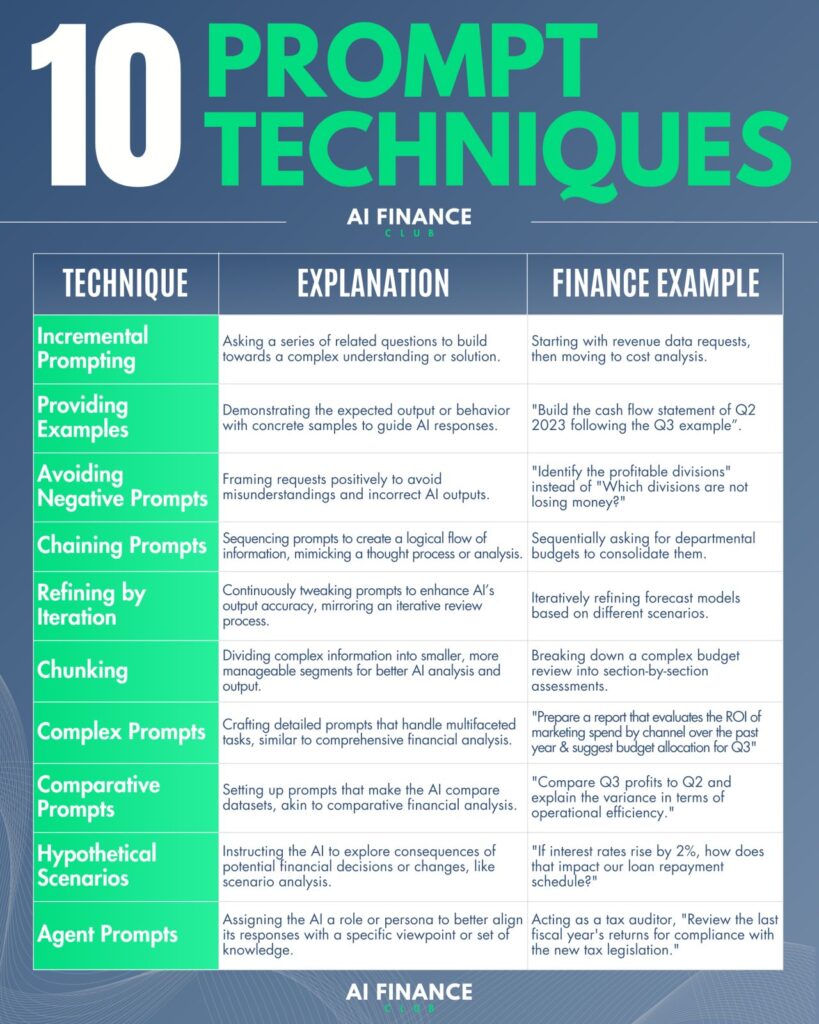Why prompt techniques are emphasized a lot nowadays?
Prompt engineering is an emerging skill set, particularly valuable in fields like business and finance.
It’s akin to financial modeling, where precision and strategy are key.
Let’s explore 10 prompt techniques that can enhance how you interact with AI for Finance.
Table of Contents
The Best Prompt Engineering Techniques
Here is the list of the top 10 prompt techniques.

#1: Providing Examples
Technique: Use specific examples to guide AI responses.
Example: “Show me a cash flow statement as we prepare for Q1 2023.”
Pro Tip: Tailor examples to closely match the complexity of your actual scenario.
#2: Incremental Prompting
Technique: Progressively build towards a comprehensive answer through related questions.
Example: Start with revenue data requests, then move to cost analysis.
Pro Tip: Ensure each prompt logically leads to the next for coherent AI responses.
#3: Avoiding Negative Prompts
Technique: Frame prompts positively to prevent misinterpretation.
Example: “Identify the profitable divisions” instead of “Which divisions are not losing money?”
Pro Tip: Positive framing often yields clearer, more direct AI responses.
#4: Chaining Prompts
Technique: Create a logical sequence of prompts, akin to a financial analysis process.
Example: Sequentially ask for departmental budgets to consolidate them.
Pro Tip: This technique is great for complex tasks requiring multiple steps.
#5: Refining by Iteration
Technique: Continuously adjust prompts to fine-tune AI responses.
Example: Iteratively refine forecast models based on AI-generated scenarios.
Pro Tip: Patience is key; iterative refinement can significantly improve accuracy.
#6: Chunking
Technique: Break down complex data into smaller, manageable pieces.
Example: Segment a complex budget review into section-by-section assessments.
Pro Tip: This approach helps in managing and understanding large data sets.
#7: Complex Prompts
Technique: Use detailed prompts for intricate tasks.
Example: “Prepare a report evaluating ROI of marketing spend by channel over the past year and suggest optimal budget allocation for the upcoming quarter.”
Pro Tip: Detailed prompts are ideal for tasks requiring in-depth analysis.
#8: Comparative Prompts
Technique: Instruct AI to draw comparisons, similar to financial analyses.
Example: “Compare Q3 profits to Q2 and explain the variance in terms of operational efficiency.”
Pro Tip: Use this to gain insights from comparative data analysis.
#9: Hypothetical Scenarios
Technique: Direct AI to assess the impacts of hypothetical financial decisions.
Example: “If interest rates rise by 2%, how does that impact our loan repayment schedule?”
Pro Tip: Great for testing out various financial scenarios and planning.
#10: Agent Prompts
Technique: Assign AI a specific role for tailored responses.
Example: As a tax auditor, “Review the last fiscal year’s returns for compliance with new tax legislation.”
Pro Tip: Assigning roles helps in receiving specialized, context-specific answers.
The Importance of Using The Right Prompt Techniques
Mastering prompt techniques is crucial as they dictate the quality and relevance of AI responses, especially in nuanced fields like finance.
These techniques ensure that interactions with AI are efficient, accurate, and aligned with specific objectives.
Final Words
Understanding and effectively using these prompt techniques can significantly enhance the quality of AI interactions in business and finance.
These techniques are not just tools; they are the bridge that connects complex financial queries with AI’s advanced capabilities.
Key Takeaways
- Precise examples guide AI towards desired outcomes.
- Incremental prompting builds comprehensive understanding.
- Positive framing yields clearer AI responses.
- Chaining prompts is effective for multi-step tasks.
- Complex prompts unlock AI’s potential in detailed analyses.
